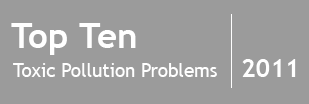Artisanal Gold Mining
Mercury Pollution
Estimated Population at Risk:
3.5 Million
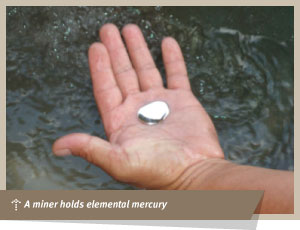 Description
Description
Artisanal mining is the term for small-scale mining operations often conducted by hand and that consist of basic extraction and processing methods for obtaining minerals and metals, including gold. It is estimated that about 10 to 20 million people worldwide work in artisanal gold mining. Artisanal miners often use toxic materials to separate metals from the surrounding ore and silt. In artisanal gold mining, the most common separation process is known as mercury amalgamation. Due to a lack of awareness, as well as lack of environmental, health, and safety regulations in these small mining industries, miners are often exposed to dangerous levels of toxic materials. The mercury used in these mining activities can also be responsible for the contamination of water and soil, posing health risks for communities near and far, but also to the global population. About 1/3 of the global annual release of mercury into the environment is due to artisanal gold mining.
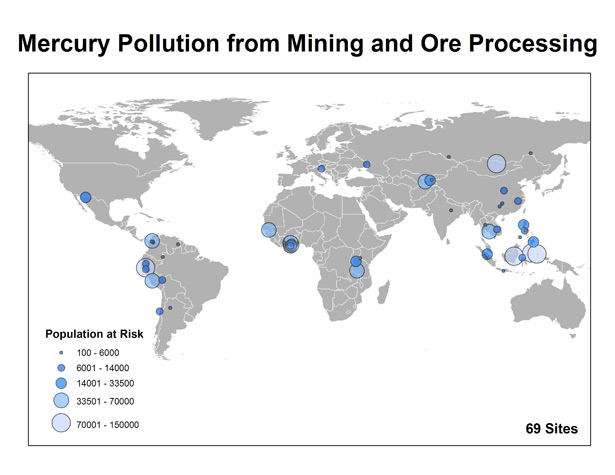
Populations estimates are preliminary and based on an ongoing global assessment of known polluted sites.
Industrial Process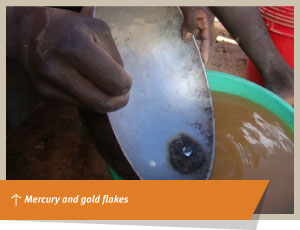 The mercury amalgamation process commonly used in artisanal gold mining mixes elemental mercury with silt or ore dust that contain tiny pieces of gold. When the mercury is added to the silt, the mercury sticks to the gold, forming a solid mercury–gold amalgam. This amalgam is then removed from the remaining silt by washing with water (the amalgam is heavier than the silt). The separated amalgam is then heated, which vaporizes the mercury, leaving behind the gold. The heating process is often conducted inside homes, as the gold is valuable and processors want security and secrecy. As the mercury is vaporized, the miners and anyone else in the vicinity, including children, are at risk of inhaling mercury. Some mercury is also left in the silt (mine tailings) because of inefficient separation of the amalgam in washing or excess mercury use. This excess mercury often makes its way into surrounding waterways when mine tailings are disposed. This mercury in waterways is then absorbed by various living organisms and is transformed into methylmercury, which is extremely hazardous to human health if digested.
The mercury amalgamation process commonly used in artisanal gold mining mixes elemental mercury with silt or ore dust that contain tiny pieces of gold. When the mercury is added to the silt, the mercury sticks to the gold, forming a solid mercury–gold amalgam. This amalgam is then removed from the remaining silt by washing with water (the amalgam is heavier than the silt). The separated amalgam is then heated, which vaporizes the mercury, leaving behind the gold. The heating process is often conducted inside homes, as the gold is valuable and processors want security and secrecy. As the mercury is vaporized, the miners and anyone else in the vicinity, including children, are at risk of inhaling mercury. Some mercury is also left in the silt (mine tailings) because of inefficient separation of the amalgam in washing or excess mercury use. This excess mercury often makes its way into surrounding waterways when mine tailings are disposed. This mercury in waterways is then absorbed by various living organisms and is transformed into methylmercury, which is extremely hazardous to human health if digested.
Global Context
Artisanal mining is a source of income for people that frequently have few alternative options to earn a comparable wage. In addition to the local and global dangers posed by mercury exposure, many artisanal mines are also very poorly constructed and unstable, and the miners face potential shaft collapses and a high risk of injury. Despite the severe health hazards, artisanal gold mining is widespread, and its practice continues to increase as the price for gold rises. Between the summer of 2009 and the summer of 2011, the price of an ounce of gold approximately doubled. To date, Blacksmith has identified over 130 sites in low- and middle-income countries where artisanal mining has caused mercury contamination, with the majority of these activities taking place in Africa and Southeast Asia, with a concentration of sites in Ghana, the Philippines, and Indonesia.
Exposure Pathways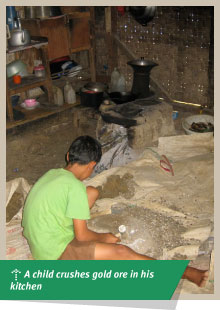 Artisanal gold mining leads to mercury exposure primarily through inhalation and ingestion. Mercury vapors are released when mercury–gold amalgam is heated to separate the gold, allowing the vapors to be inhaled by miners and their families. Mercury vapor can also spread from the amalgamation-heating site through the air to distant communities. Excess liquid mercury used in the gold amalgamation process is often dumped with mine tailings and enters waterways. Mercury enters streams as inorganic mercury, where it is converted to the more toxic methylmercury by organisms. The methylmercury bio-accumulates in fish, moving up the food chain to species eaten by humans. Though mercury accumulation is most commonly associated with large, predatory fish, traces have also been found in birds, reptiles, and mammals, all of which can spread mercury to humans if consumed.
Artisanal gold mining leads to mercury exposure primarily through inhalation and ingestion. Mercury vapors are released when mercury–gold amalgam is heated to separate the gold, allowing the vapors to be inhaled by miners and their families. Mercury vapor can also spread from the amalgamation-heating site through the air to distant communities. Excess liquid mercury used in the gold amalgamation process is often dumped with mine tailings and enters waterways. Mercury enters streams as inorganic mercury, where it is converted to the more toxic methylmercury by organisms. The methylmercury bio-accumulates in fish, moving up the food chain to species eaten by humans. Though mercury accumulation is most commonly associated with large, predatory fish, traces have also been found in birds, reptiles, and mammals, all of which can spread mercury to humans if consumed.
Inhaling mercury vapors from the amalgam heating process is the most direct pathway of exposure. Unlike mercury in the food chain that must accumulate over time, exposure to the vapors is immediate and can result in direct exposure to dangerous levels of mercury. A study of artisanal mining practices in Peru found that for every gram of gold produced using the amalgamation process, at least two grams of mercury were released into the air.14

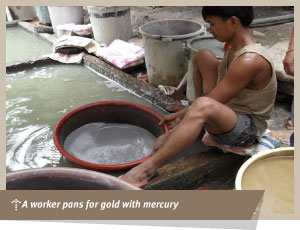 Health Effects
Health Effects
The health hazards that result from exposure to mercury depend on the level of exposure and the way in which the pollutant enters the body. Inhalation of mercury vapor is particularly hazardous for kidneys, the central nervous system, and the respiratory and cardiovascular systems15. Inhalation of mercury vapor has also been found to cause neurobehavioral disorders, such as hand tremor and mental retardation. Exposure to other forms of mercury – and in particular the methylmercury that accumulates in fish – can also lead to problems with the kidneys, lungs, and central nervous system, in addition to arthritis, reproductive problems, loss of memory, psychosis, and in some cases, death. Children exposed to mercury contamination have a higher risk of developmental complications.
What is Being Done
Though the environmental and health problems associated with artisanal gold mining are numerous, there are relatively easy, effective, and inexpensive methods of reducing negative impacts. Blacksmith and Green Cross Switzerland, in conjunction with UNIDO’s Global Mercury Project, have been working to introduce programs, technology, and training that will help artisanal miners reduce the amount of mercury to which that they are exposed. These efforts revolve around the introduction of a mercury retort device, which limits the amount of fugitive mercury emissions and also allows miners to recapture and reuse mercury. Retorts are built by local craftsmen using locally available materials. This technology is simple and economical, allowing the miners to save money while reducing health risks.
Though these programs can be very successful on a small scale, the effective implementation of retort technology relies heavily on proper training and education. To this end, Blacksmith, in partnership with local governments and NGOs, has implemented training programs in Mozambique, Senegal, Indonesia, and Cambodia that can be replicated on a larger scale. 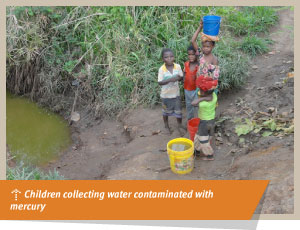 Example – DALY Calculations
Example – DALY Calculations
Our research process for calculating DALYs associated with pollutants from particular industries found that there is currently too little information on health impacts caused by exposure to mercury from artisanal gold mining. The data that Blacksmith has collected to date on samples from artisanal gold mining sites are also incomplete, and do not include enough information on samples of mercury in air, which is one of the more dangerous exposure routes for the toxin. Due to these limitations, we are unable to calculate a DALY estimate for mercury exposure from artisanal mining at this time. Blacksmith, however, is currently conducting projects in Africa that will help to fill some of the gaps in this research and data in the future.
Footnotes:
[14]: “Slum at the Summit.” Earth Report. Television Trust for the Environment. Accessed on August 22, 2011. Available at: http://www.tve.org/earthreport/archive/doc.cfm?aid=1623.
[15]: “Toxicological Profile for Mercury.” U.S. Department of Health and Human Services. March, 1999. Available at: http://www.atsdr.cdc.gov/toxprofiles/tp.asp?id=115&tid=24.

-
Artisanal Gold Mining
Mercury Pollution
-
Industrial Estates
Lead Pollution
-
Agricultural Production
Pesticide Pollution
-
Lead Smelting
Lead Pollution
-
Tannery Operations
Chromium Pollution
-
Mining and Ore Processing
Mercury Pollution
-
Mining and Ore Processing
Lead Pollution
-
Lead-Acid Battery Recycling
Lead Pollution
-
Arsenic in Groundwater
Arsenic Pollution
-
Pesticide Manufacturing and Storage
Pesticide Pollution
-
The Rest of the Toxic Twenty

